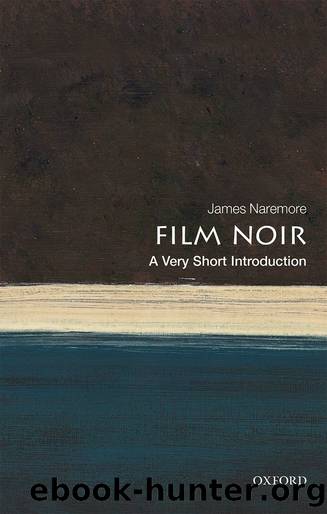Film Noir: A Very Short Introduction by James Naremore

Author:James Naremore [Naremore, James]
Language: eng
Format: epub
Tags: Art, Cultural & Social, Film, Media Studies, Performing Arts, Popular culture, Social Science
ISBN: 9780192509512
Google: 6hqJDwAAQBAJ
Amazon: 0198791747
Publisher: Oxford University Press
Published: 2019-02-15T03:00:00+00:00
The other side of town
Much could be written (and has been) about the cultural politics of film noir, which has been affected not only by such official agencies as the PCA, but also, more indirectly, by the general cultureâs treatment of women and minorities. One reason noir is interesting from this perspective is that it has so many âin-betweenâ or mixed qualities: it occupies a liminal space between art and potboilers; it involves both action pictures and âwomenâsâ melodramas; it often centers on a zone between the law and the underworld; and its action keeps moving back and forth between respectable and disreputable areas of town, bringing together people of different status. (As art-dealer Clifton Webb remarks in The Dark Corner, the fancy parties he gives are âa nauseating mixture of Park Avenue and Broadway.â) Sometimesâmost conspicuously in Touch of Evilâit involves crossing and re-crossing actual borders. Aside from frontier westerns about cowboys and Indians, it offers middle-class white audiences their most frequent opportunity to see âothersâ: sexually independent women, homosexuals, Asians, Latins, and blacks.
Feminist film critics and theorists share no single position on the sexual politics of noir, in part because many classic examples displace the patriarchal family in favor of lone wolves and spider women. Although the noir femme fatale has origins in male fears of modern women, and although she usually comes to a bad end, she nevertheless remains a threat to the proper order of things and does what E. Ann Kaplan describes as important âideological work.â Some of this work is made explicit in The Big Heat, when gangsterâs moll Gloria Grahame confronts the widow of a police chief, describing herself and her apparent opposite as âsisters under the mink.â Many noir films in the 1940s try to contrast the tough, sexy bad girl with the housewife and mother or the virginal innocent (examples can be seen in Double Indemnity, The Big Heat, and Out of the Past), but the bad girl is always the most fascinating character. Certain of the films play with this good/bad distinction in interesting and potentially subversive ways: see especially Pitfall (1948) and The Narrow Margin (1952). Notice also that certain noir-like womenâs melodramas undercut the formula for what Hollywood once called âwomenâs weepies.â R. Barton Palmer has pointed out that Possessed and Cause for Alarm (1947) differ from a non-noir melodrama such as Now, Voyager (1942) because they donât offer a âcompromised yet satisfying wish fulfillmentâthat is, the heroine put back in her place but offered a different, rewarding life.â
An equally mixed set of responses can be found in discussions of noir masculinity and homosexuality. Although the Production Code of the 1940s explicitly forbade the depiction of homosexuality, the repressed returned in various ways. The tough, masculine novels of Hammett and Chandler had latently homosexual characters that were transposed into the films. Sometimes homosexuality was stereotyped, as in Bogartâs imitation of a lisping bibliophile in The Big Sleep, but more often the villains were subtly portrayed as homosexual, as in The Maltese Falcon, Rope (1948), The Big Heat, and Strangers on a Train.
Download
This site does not store any files on its server. We only index and link to content provided by other sites. Please contact the content providers to delete copyright contents if any and email us, we'll remove relevant links or contents immediately.
Kathy Andrews Collection by Kathy Andrews(11680)
The remains of the day by Kazuo Ishiguro(8748)
Paper Towns by Green John(5024)
Spare by Prince Harry The Duke of Sussex(4997)
The Body: A Guide for Occupants by Bill Bryson(4887)
Industrial Automation from Scratch: A hands-on guide to using sensors, actuators, PLCs, HMIs, and SCADA to automate industrial processes by Olushola Akande(4846)
Machine Learning at Scale with H2O by Gregory Keys | David Whiting(3973)
Be in a Treehouse by Pete Nelson(3876)
Harry Potter and the Goblet Of Fire by J.K. Rowling(3739)
Never by Ken Follett(3706)
Goodbye Paradise(3666)
Into Thin Air by Jon Krakauer(3261)
The Remains of the Day by Kazuo Ishiguro(3254)
The Cellar by Natasha Preston(3220)
The Genius of Japanese Carpentry by Azby Brown(3192)
Fairy Tale by Stephen King(3157)
120 Days of Sodom by Marquis de Sade(3118)
Drawing Shortcuts: Developing Quick Drawing Skills Using Today's Technology by Leggitt Jim(2960)
The Man Who Died Twice by Richard Osman(2957)
